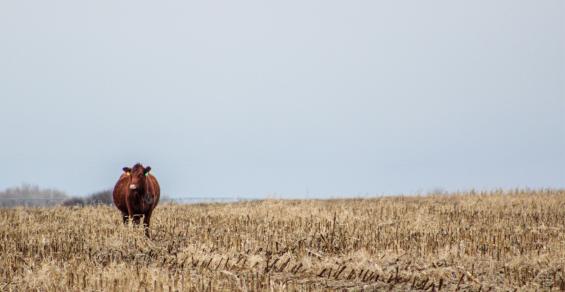While grazing cornstalks is one way to reduce winter grazing costs, the term “grazing cornstalks” is misleading. North Dakota State University Extension specialists say cattle shouldn’t be forced to graze the actual stalk of the corn plant.
“The components of the corn plant remaining postharvest include the stalk, leaf, husk, cob and any downed ears,” says Zac Carlson, NDSU Extension beef cattle specialist. “The components with the greatest nutritive value are the husk and leaf. The cob is relatively high in digestibility but low in protein. The stalk is low in protein and digestibility.”
“Cattle are selective grazers and will eat any grain first that is remaining in the field, followed by husk and leaf,” he says. “As a consequence, the longer the cattle graze a particular corn field, the lower in nutrient content their diet will be.”
Therefore, farmers and ranchers should target cattle to consume husk and leaf, and use the visual appearance of husk and leaf as an indicator of when to move cattle to the next field, Carlson advises.
“For each bushel of corn produced, there is approximately 16 pounds of leaf and husk available,” says Janna Block, NDSU Extension livestock systems specialist. “A suggested stocking rate is to target grazing half of the available leaf and husk,” or about 8 pounds per bushel of corn produced.
Provide adequate nutrition
Mature, nonlactating, spring-calving cows with a body condition score of 5 or greater will not need supplemental protein when grazing corn residue in favorable weather at an appropriate stocking rate.
Weaned calves, first-calf heifers and fall-calving cows will require additional protein and energy to meet nutrient requirements.
“Corn residue is low in most minerals and vitamin A,” says Karl Hoppe, NDSU Extension livestock systems specialist. “Farmers and ranchers should provide a vitamin and mineral program when grazing corn residue.” Scout fields prior to grazing to determine the amount of downed corn present.
“There is an increased risk of founder or acidosis if fields have 8 to 10 or more bushels of ears of corn per acre,” says James Rogers, NDSU Extension forage crops production specialist. “If this is the case, strip grazing is recommended to limit the amount of corn consumed in one day.”
To determine the amount of corn remaining in fields planted in 30-inch rows, count the number of 8-inch ears (or equivalent) on the ground along three different 100-foot furrow strips, and then divide the total by two. This will give an estimate for bushels of corn per acre remaining in the field, Rogers says.
“Do not turn hungry cattle out to graze,” advises Miranda Meehan, NDSU Extension livestock stewardship specialist. “Provide good-quality hay for a day or more so cattle don’t consume corn immediately. Allow cattle to fill up on hay before grazing corn residue.”
Grazing limitations
Two main limitations to grazing corn residue are installing fence and providing water for grazing cattle.
Soil compaction is another issue often attributed to grazing corn residue. Based on research conducted at USDA’s Northern Plains Research Lab in Mandan, N.D., the risk of compaction from fall grazing is low in the northern Great Plains due to freeze-thaw cycles. However, NDSU Extension specialists recommend that producers avoid grazing soils with a high clay content when saturated.
“Have a plan for weather events that limit grazing,” Meehan says. “Deep snow and ice will limit the ability for cattle to graze corn residue. Have additional feed resources available when the weather gets bad.”
Turning cattle out to fields of corn stubble provides extra grazing opportunities.



